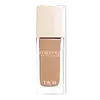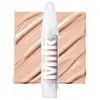What's inside
What's inside
 Key Ingredients
Key Ingredients

 Benefits
Benefits

 Concerns
Concerns

 Ingredients Side-by-side
Ingredients Side-by-side

Water
Skin ConditioningC9-12 Alkane
SolventCaprylic/Capric Triglyceride
MaskingPropanediol
SolventGlycerin
HumectantCoco-Caprylate/Caprate
EmollientC15-19 Alkane
SolventPentylene Glycol
Skin ConditioningPullulan
Sorbitan Sesquiisostearate
EmulsifyingStearalkonium Hectorite
Gel FormingTrimethylsiloxysilicate
EmollientPolyglyceryl-3 Polyricinoleate
EmulsifyingPolyglyceryl-3 Diisostearate
EmulsifyingParfum
MaskingSodium Chloride
MaskingButylene Glycol
HumectantSodium Myristoyl Glutamate
CleansingHydroxyacetophenone
AntioxidantEthylhexylglycerin
Skin ConditioningPotassium Sorbate
PreservativeHibiscus Sabdariffa Flower Extract
Skin ConditioningAluminum Hydroxide
EmollientPolyhydroxystearic Acid
EmulsifyingHydrolyzed Viola Tricolor Extract
Skin ProtectingRosa Multiflora Fruit Extract
MaskingTropaeolum Majus Flower/Leaf/Stem Extract
Skin Conditioning1,2-Hexanediol
Skin ConditioningCaprylyl Glycol
EmollientIsostearic Acid
CleansingLecithin
EmollientCitric Acid
BufferingTocopherol
AntioxidantCI 77491
Cosmetic ColorantCI 77492
Cosmetic ColorantCI 77499
Cosmetic ColorantCI 77891
Cosmetic ColorantWater, C9-12 Alkane, Caprylic/Capric Triglyceride, Propanediol, Glycerin, Coco-Caprylate/Caprate, C15-19 Alkane, Pentylene Glycol, Pullulan, Sorbitan Sesquiisostearate, Stearalkonium Hectorite, Trimethylsiloxysilicate, Polyglyceryl-3 Polyricinoleate, Polyglyceryl-3 Diisostearate, Parfum, Sodium Chloride, Butylene Glycol, Sodium Myristoyl Glutamate, Hydroxyacetophenone, Ethylhexylglycerin, Potassium Sorbate, Hibiscus Sabdariffa Flower Extract, Aluminum Hydroxide, Polyhydroxystearic Acid, Hydrolyzed Viola Tricolor Extract, Rosa Multiflora Fruit Extract, Tropaeolum Majus Flower/Leaf/Stem Extract, 1,2-Hexanediol, Caprylyl Glycol, Isostearic Acid, Lecithin, Citric Acid, Tocopherol, CI 77491, CI 77492, CI 77499, CI 77891
Homosalate 5%
Skin ConditioningEthylhexyl Salicylate 4.5%
UV AbsorberOctocrylene 5%
UV AbsorberTitanium Dioxide 2.9%
Cosmetic ColorantZinc Oxide 5.1%
Cosmetic ColorantWater
Skin ConditioningButylene Glycol
HumectantCrambe Abyssinica Seed Oil Phytosterol Esters
EmulsifyingCaprylic/Capric Triglyceride
MaskingSqualane
EmollientGlyceryl Oleate
EmollientPolyglyceryl-3 Polyricinoleate
EmulsifyingPentylene Glycol
Skin ConditioningSilica
AbrasiveDiisostearyl Malate
EmollientSodium Chloride
MaskingStearalkonium Hectorite
Gel FormingSimmondsia Chinensis Seed Oil
EmollientOlea Europaea Fruit Oil
MaskingPersea Gratissima Oil
Skin ConditioningVitis Vinifera Seed Oil
EmollientCitrus Nobilis Peel Oil
MaskingTremella Fuciformis Sporocarp Extract
AntioxidantLonicera Japonica Flower Extract
Skin ConditioningTocopheryl Acetate
AntioxidantTribehenin
EmollientMagnesium Aluminum Silicate
AbsorbentIsostearic Acid
CleansingLecithin
EmollientPolyhydroxystearic Acid
EmulsifyingHydrogenated Olive Oil Unsaponifiables
EmollientAlumina
AbrasiveStearic Acid
CleansingJojoba Esters
EmollientGlycerin
HumectantOlea Europaea Oil Unsaponifiables
Skin ConditioningAcacia Senegal Gum
MaskingEthylhexylglycerin
Skin ConditioningXanthan Gum
EmulsifyingBetaine
HumectantPotassium Sorbate
PreservativePhenoxyethanol
PreservativeParfum
MaskingIron Oxides
Homosalate 5%, Ethylhexyl Salicylate 4.5%, Octocrylene 5%, Titanium Dioxide 2.9%, Zinc Oxide 5.1%, Water, Butylene Glycol, Crambe Abyssinica Seed Oil Phytosterol Esters, Caprylic/Capric Triglyceride, Squalane, Glyceryl Oleate, Polyglyceryl-3 Polyricinoleate, Pentylene Glycol, Silica, Diisostearyl Malate, Sodium Chloride, Stearalkonium Hectorite, Simmondsia Chinensis Seed Oil, Olea Europaea Fruit Oil, Persea Gratissima Oil, Vitis Vinifera Seed Oil, Citrus Nobilis Peel Oil, Tremella Fuciformis Sporocarp Extract, Lonicera Japonica Flower Extract, Tocopheryl Acetate, Tribehenin, Magnesium Aluminum Silicate, Isostearic Acid, Lecithin, Polyhydroxystearic Acid, Hydrogenated Olive Oil Unsaponifiables, Alumina, Stearic Acid, Jojoba Esters, Glycerin, Olea Europaea Oil Unsaponifiables, Acacia Senegal Gum, Ethylhexylglycerin, Xanthan Gum, Betaine, Potassium Sorbate, Phenoxyethanol, Parfum, Iron Oxides
 Reviews
Reviews

Ingredients Explained
These ingredients are found in both products.
Ingredients higher up in an ingredient list are typically present in a larger amount.
Butylene Glycol (or BG) is used within cosmetic products for a few different reasons:
Overall, Butylene Glycol is a safe and well-rounded ingredient that works well with other ingredients.
Though this ingredient works well with most skin types, some people with sensitive skin may experience a reaction such as allergic rashes, closed comedones, or itchiness.
Learn more about Butylene GlycolThis ingredient is an emollient, solvent, and texture enhancer. It is considered a skin-softener by helping the skin prevent moisture loss.
It helps thicken a product's formula and makes it easier to spread by dissolving clumping compounds.
Caprylic Triglyceride is made by combining glycerin with coconut oil, forming a clear liquid.
While there is an assumption Caprylic Triglyceride can clog pores due to it being derived from coconut oil, there is no research supporting this.
Learn more about Caprylic/Capric TriglycerideEthylhexylglycerin (we can't pronounce this either) is commonly used as a preservative and skin softener. It is derived from glyceryl.
You might see Ethylhexylglycerin often paired with other preservatives such as phenoxyethanol. Ethylhexylglycerin has been found to increase the effectiveness of these other preservatives.
Glycerin is already naturally found in your skin. It helps moisturize and protect your skin.
A study from 2016 found glycerin to be more effective as a humectant than AHAs and hyaluronic acid.
As a humectant, it helps the skin stay hydrated by pulling moisture to your skin. The low molecular weight of glycerin allows it to pull moisture into the deeper layers of your skin.
Hydrated skin improves your skin barrier; Your skin barrier helps protect against irritants and bacteria.
Glycerin has also been found to have antimicrobial and antiviral properties. Due to these properties, glycerin is often used in wound and burn treatments.
In cosmetics, glycerin is usually derived from plants such as soybean or palm. However, it can also be sourced from animals, such as tallow or animal fat.
This ingredient is organic, colorless, odorless, and non-toxic.
Glycerin is the name for this ingredient in American English. British English uses Glycerol/Glycerine.
Learn more about GlycerinIsostearic acid is a saturated fatty acid. Its structure makes it a great surfactant.
Surfactants help decrease the surface tension between two liquids. This property also makes it an effective emulsifier. Emulsifiers help prevent waters and oils from separating in a product.
Isostearic Acid is created from oleic acid.
This ingredient may not be Malassezia folliculitis, or fungal-acne safe.
Learn more about Isostearic AcidLecithin is a term for a group of substances found in the cell membranes of plants, animals, and humans. They are made up of mixture of phospholipids.
This ingredient has emollient and emulsifying properties.
As an emollient, lecithen helps soften the skin and creates a barrier to keep moisture in.
As an emulsifier, it also helps prevent water and oil ingredients from separating. Lecithin can also help ingredients be better absorbed by the skin.
This is because the phospholipids in lecithin produce liposomes. Liposomes help other ingredients get through the skin barrier.
Depending on the source of this ingredient, lecithin may not be fungal acne safe. This is because some sources of lecithin come from soybean oil, which may feed the malassezia yeast that feeds fungal acne.
We recommend reaching out to the brand you are purchasing from to inquire about the source of their lecithin.
Some other names for this ingredient include soy lecithin and deoiled soy lecithin.
Learn more about LecithinParfum is a catch-all term for an ingredient or more that is used to give a scent to products.
Also called "fragrance", this ingredient can be a blend of hundreds of chemicals or plant oils. This means every product with "fragrance" or "parfum" in the ingredients list is a different mixture.
For instance, Habanolide is a proprietary trade name for a specific aroma chemical. When used as a fragrance ingredient in cosmetics, most aroma chemicals fall under the broad labeling category of “FRAGRANCE” or “PARFUM” according to EU and US regulations.
The term 'parfum' or 'fragrance' is not regulated in many countries. In many cases, it is up to the brand to define this term.
For instance, many brands choose to label themselves as "fragrance-free" because they are not using synthetic fragrances. However, their products may still contain ingredients such as essential oils that are considered a fragrance by INCI standards.
One example is Calendula flower extract. Calendula is an essential oil that still imparts a scent or 'fragrance'.
Depending on the blend, the ingredients in the mixture can cause allergies and sensitivities on the skin. Some ingredients that are known EU allergens include linalool and citronellol.
Parfum can also be used to mask or cover an unpleasant scent.
The bottom line is: not all fragrances/parfum/ingredients are created equally. If you are worried about fragrances, we recommend taking a closer look at an ingredient. And of course, we always recommend speaking with a professional.
Learn more about ParfumPentylene glycol is typically used within a product to thicken it. It also adds a smooth, soft, and moisturizing feel to the product. It is naturally found in plants such as sugar beets.
The hydrophilic trait of Pentylene Glycol makes it a humectant. As a humectant, Pentylene Glycol helps draw moisture from the air to your skin. This can help keep your skin hydrated.
This property also makes Pentylene Glycol a great texture enhancer. It can also help thicken or stabilize a product.
Pentylene Glycol also acts as a mild preservative and helps to keep a product microbe-free.
Some people may experience mild eye and skin irritation from Pentylene Glycol. We always recommend speaking with a professional about using this ingredient in your routine.
Pentylene Glycol has a low molecular weight and is part of the 1,2-glycol family.
Learn more about Pentylene GlycolThis ingredient is an emulsifier. It is created from Polyglycerin-3 and Ricinoleic Acid.
As an emulsifier, it prevents waters and oils from separating. According to a manufacturer this ingredient is fully biodegradable.
This ingredient may not be safe for Malassezia folliculitis due to its Ricinoleic Acid base. Ricinoleic Acid is a fatty acid derived from castor oil.
Learn more about Polyglyceryl-3 PolyricinoleatePolyhydroxystearic Acid is a soft wax made from castor oil.
It is is a texture thickener, emulsifier, and film-former. Emulsifiers prevent ingredients from separating, such as oils and waters.
Polyhydroxystearic Acid may not be fungal acne safe.
Learn more about Polyhydroxystearic AcidPotassium Sorbate is a preservative used to prevent yeast and mold in products. It is commonly found in both cosmetic and food products.
This ingredient comes from potassium salt derived from sorbic acid. Sorbic acid is a natural antibiotic and effective against fungus.
Both potassium sorbate and sorbic acid can be found in baked goods, cheeses, dried meats, dried fruit, ice cream, pickles, wine, yogurt, and more.
You'll often find this ingredient used with other preservatives.
Learn more about Potassium SorbateChances are, you eat sodium chloride every day. Sodium Chloride is also known as table salt.
This ingredient has many purposes in skincare: thickener, emulsifier, and exfoliator.
You'll most likely find this ingredient in cleansers where it is used to create a gel-like texture. As an emulsifier, it also prevents ingredients from separating.
There is much debate on whether this ingredient is comedogenic. The short answer - comedogenic ratings don't tell the whole story. Learn more about comegodenic ratings here.
The concensus about this ingredient causing acne seems to be divided. Research is needed to understand if this ingredient does cause acne.
Scrubs may use salt as the primary exfoliating ingredient.
Learn more about Sodium ChlorideStearalkonium Hectorite is a clay-derived ingredient used to thicken a product and help create a gel-like texture.
Water. It's the most common cosmetic ingredient of all. You'll usually see it at the top of ingredient lists, meaning that it makes up the largest part of the product.
So why is it so popular? Water most often acts as a solvent - this means that it helps dissolve other ingredients into the formulation.
You'll also recognize water as that liquid we all need to stay alive. If you see this, drink a glass of water. Stay hydrated!
Learn more about Water